Insulated Metal Panels On the Roof
An all-in-one building enclosure solution
![]() Continuing Education
Continuing Education
Use the following learning objectives to focus your study while reading this month’s Continuing Education article.
Learning Objectives - After reading this article, you will be able to:
- Describe the advantages of insulated metal roofing panels for roofing as an all-in-one air, vapor, and water barrier solution, along with the continuous insulation requirements mandated by many codes.
- Compare the benefits of IMP roofing to common roofing alternatives.
- Identify the growing importance of a high-performing building enclosure and how IMPs support this goal.
- Discuss a number of best practices for the optimized design and installation of IMP roofing systems.
As an all-in-one air, vapor, and water barrier with continuous thermal insulation, insulated metal panels (IMPs) for roofing are an ideal way to meet today’s increasingly stringent building codes.
The prefabricated units, when installed correctly, can contribute significantly to the building enclosure’s thermal performance levels, while simultaneously enabling fast-tracked construction and lower field labor costs.
Made from rigid foam injected into two sheets of metal, Phil Kazba, FCSI, CCS, AIA, SpecGuy Specifications Consultants, Mount Dora, Florida, describes IMP roof and wall systems as providing the closest-to-perfect solution for uniform temperature, moisture, air, and water vapor control.
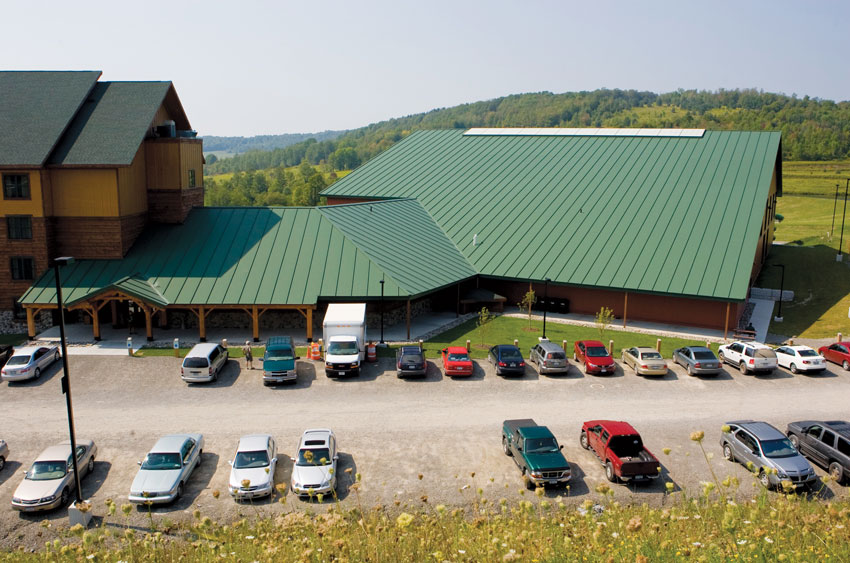
All images courtesy of Metl-Span
The Hope Lake complex, pictured here in Cortland, New York, used standing seam insulated metal roofing panels as a perfect all-in-one air, vapor, water, and thermal solution to cover an indoor water amusement park with high moisture in the air.
Originally developed for large industrial facilities requiring space conditioning, growing interest in continuous insulation performance, partially driven by the codes, has helped propel IMPs into the architectural realm, making it a suitable choice for arenas, schools, office buildings, fire stations, transportation hubs, and airport facilities.
“The panels are relatively lightweight, installation and erection is relatively fast, and the panels function as a structural deck, insulation, and finish system all-in-one package that can span over supports/purlins,” reports Richard S. Koziol, AIA, NCARB, principal, Wiss, Janney, Elstner Associates Inc., Northbrook, Illinois.
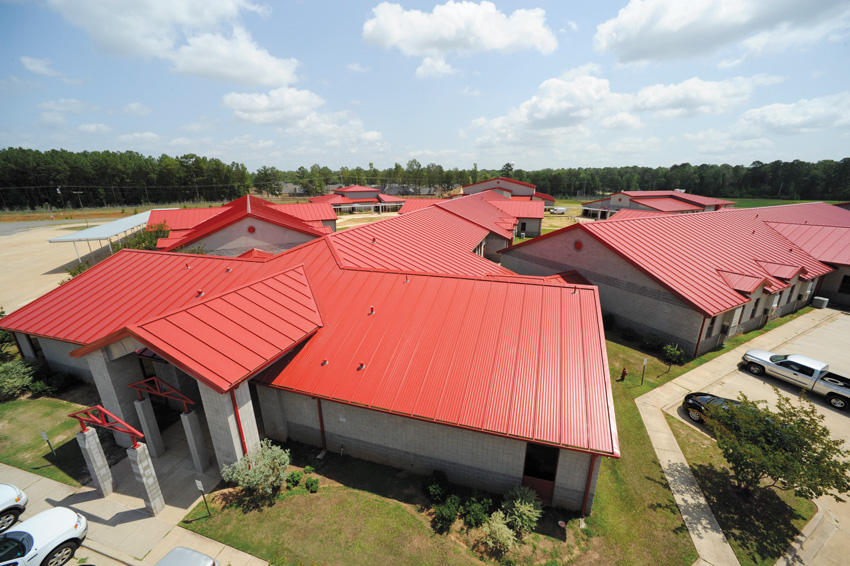
The Windy City architect also sees IMP roofing systems as best suited for steel-frame buildings having a minimum roof pitch of 1:12 and steeper, and for roof geometries that are simple and straightforward.
“One of the most apparent advantages of the IMPs over other roofing methods is the significant reduction in installation steps and trades responsible for installation of the roof,” states Todd Wolf, principal, building science specialist, BCRA Nexus, Tacoma, Washington. “In certain climates and environments, this reduction also translates into less exposure of other building components to the elements, with a faster dry-in period and less sensitivity to the weather conditions during installation.”
And because the panels are attached by a simple pre-engineered combination of clips, fasteners, and substrate, they are not subject to failures resulting in incompatibility amongst components, moisture within the system, application temperatures, or similar failure modes present in membrane roofing, according to Kazba.
“Virtually maintenance-free, IMPs are subject to very occasional inspection to verify substrate movement or improper fastening have not led to joint or flashing displacement,” he adds.
Evaluating Alternatives
In comparing IMPs to other roofing alternatives—namely built-up roof membranes, EPDM (ethylene propylene diene terpolymer) rubber roofing, and modified bitumen (modbit)—IMPs offer a number of advantages.
For starters, the above-mentioned roofing materials either have an adhesive or the plys must be touch applied, thereby creating an unpleasant odor, which can be disruptive when retrofitting an existing operating building.
Even more serious, torch-applied modbit is known to cause leaking and moisture infiltration in cases where the moisture barrier is improperly installed, says Sam Williamson, co-founder, KBHomeSpecialists, Glasgow, Scotland.
“In the case of EPDM, the main issue is it is still a relatively recent innovation, and finding workers who are skilled enough to install the system correctly can be difficult,” he explains. “On the contrary, IMPs can be installed very easily and are far more resilient than rubber EPDM.”
While built-up systems offer a high level of waterproofing, they come along with higher installation costs, a slower installation schedule, and are more susceptible to wind and water damage.
Of course, another significant factor is a noted difference in life expectancy. Whereas built-up, modbit and EPDM will last between 15 and 20 years, metal roofing offers more than 40 years with little maintenance. Once modbit and EPDM start to fail, the insulation begins absorbing moisture, at which point the materials have little to no insulation value.
In fact, IMPs really stand out when it comes to insulation, lending higher R-values per inch, as compared to the alternatives. Take a standard thermal transmission test, at an average 75 degrees Fahrenheit, for example. The R-value of a 2-inch IMP clocks in at 14.28, at 4 inches the R-value is 28.6, and a 6-inch IMP has an R-value of 42.9. To compare, a 3.5-inch layer of fiberglass insulation registers an R-value of 11, and 6 inches offers an R-value of 19.
Another disadvantage with fiberglass is the R-value becomes compromised when compressed. This inconsistency in the fiberglass thickness, coupled with an added requirement for manual labor to secure it to the frame, leaves a noted margin of error. Furthermore, fiberglass insulation has a facing on the interior side, which is vulnerable to damage when exposed to a building’s interior.
Conversely, IMPs have an advanced polyurethane core sandwiched between two metal skins, capable of delivering a consistent, long-term R-value. When properly installed and sealed, the insulation becomes encapsulated by metal trim, effectively creating an impermeable membrane around the panel.
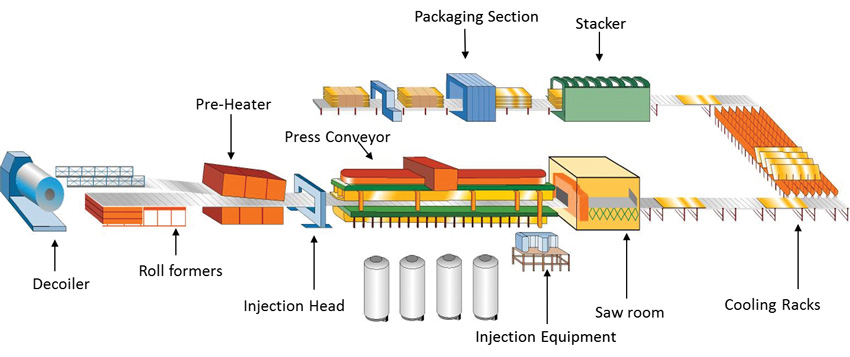
By injecting a polyurethane core into two metal facings, the insulation is encapsulated by metal trim, which creates an impermeable membrane around the panel, thereby protecting the insulation.
The Building Enclosure
When considering an IMP roof, an important factor is the fact that it is capable of supporting a high-performing building enclosure, which has evolved into a sought-after building feature in recent years.
“The amount of energy, and consequently heat, that is lost through poorly insulated roof and walls is staggering. Building owners have no problem getting heat into their facilities, but keeping it there is another matter entirely,” notes Williamson.
Consequently, “a thermally efficient, well-sealed enclosure is paramount to a building’s overall energy efficiency,” states Richard Keleher, AIA, CSI, LEED AP, senior architect, The Thompson & Lichtner Company, Canton, Massachusetts. “In fact, it is the first thing that should be done when planning for energy efficiency.”
Offering energy savings between 20 percent and 40 percent, particularly in climates with extreme cold or heat, properly sealing the envelope has become a big focus for today’s buildings.
Recognizing the criticality of the building enclosure, the U.S. Army Corps of Engineers actually requires its buildings to undergo whole building air leakage testing, in addition to meeting ASHRAE’s 90.1 standard for a tight building enclosure. While somewhat less aggressive, the International Energy Conservation Code (IECC) has also jumped on the bandwagon, requiring air tightness levels at 25 percent less than ASHRAE 90.1. Based upon the U.S. Department of Energy’s latest Status of Energy Code Adoption map earlier this year, 25 states have adopted some form of the 2012/2015 IECC air leakage standard, which permits air leakage compliance through either the air tightness of the individual components or through the continuity of the entire air barrier assembly, as verified through a whole building air leakage test.
“When performing a whole building test, both the components, and more importantly, the continuity of transitions between components and materials, is of paramount importance,” relates Wolf. “The IMPs our firm has tested have an advantage over other building components and assemblies during a whole building air leakage test in that the metal on the panels is an excellent air barrier material, and the panel assemblies are frequently designed and fabricated to interlock in a tongue-and-groove method with sealant along all of the groove edges.”
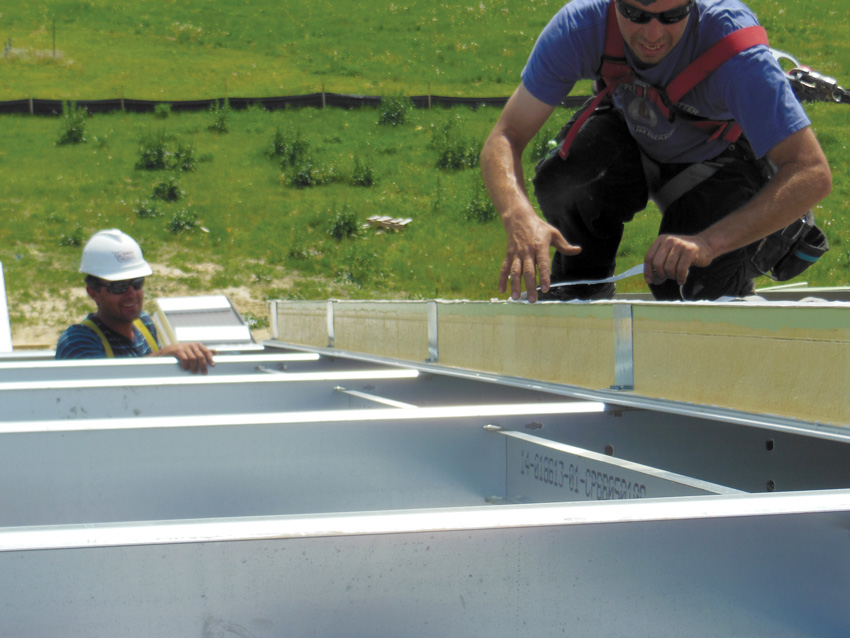
To achieve proper air and water infiltration for the IMP system, a proper seal system is critical.
“When the panels are properly installed with continuous seals at panel joints and proper roof-to-wall transitions, the effective air leakage rate is reduced to near ASHRAE’s tight building standard of 0.10cfm/sf of air leakage at a pressure differential of 75 Pa,” he adds.
A key detail for achieving a thermally efficient building enclosure is having the insulation on a continuous plane with minimal joints and seams to prevent thermal bridges where insulation can escape, explains Koziol. Because IMP roof systems typically have a single-layer plane of insulation with a sealed side and end joints or laps for moisture resistance, as well as thermal efficiency, they are a very good option for energy savings.
Putting things into perspective, IMPs offer close to three times the insulation efficiency as a field assembled glass fiber system, according to the Glenview, Illinois-based Metal Construction Association (MCA). As delineated in MCA’s Selection Guide for Insulated Metal Panels (available as a free download at www.metalconstruction.org/download.php/education/downloads/user_file_5), to achieve an R-value of 20 with an IMP, only a 23/4-inch to 3-inch thickness is required, whereas the same R-20 with glass fiber—along with a separate liner, sub girt, and fascia—will require an approximate 71/2-inch-thick roof or wall system.
The guide also points out that IMP thermal performance is enhanced because there is no metal conductance from exterior to interior skin.
“The materials used on the roof have a huge impact on how energy efficient it is, and IMPs are easily one of the best choices,” confirms Williamson.
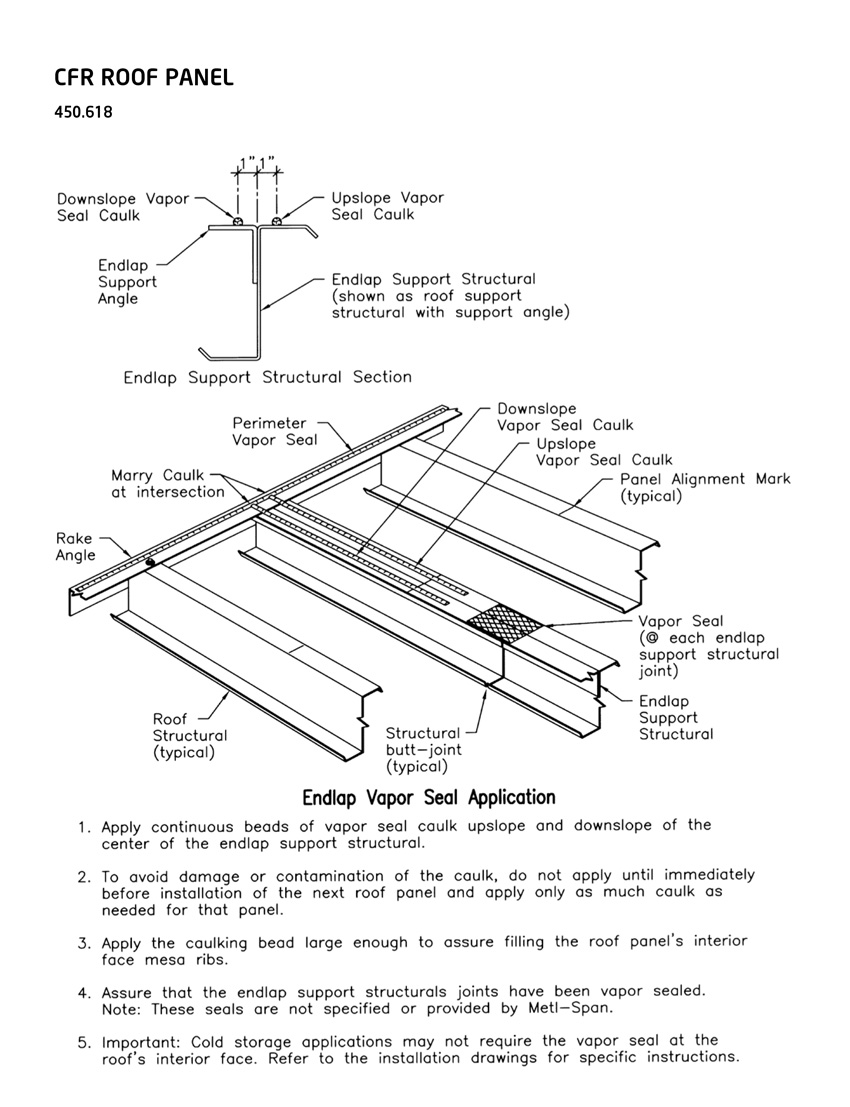
The proper allocation of vapor barrier sealant is essential for a proper endlap installation.
Of course, this is assuming the IMP system is properly detailed and installed. Along these lines, penetrations through the roof should be kept to a minimum because flashing them for long-term durability and water tightness can be challenging, according to Koziol.
Besides compromising energy efficiency, Jim Halle, exterior envelope superintendent, Gilbane Building Company, Albany, New York, points out that without a complete thermally efficient building envelope, the building will not function correctly. “The external elements will cause water infiltration and condensation within the building. This will cause deterioration of interior materials, mold, and insect infestation, preventing the building from being commissioned correctly.”
Of course, the key to certifying a high-performance enclosure is ensuring that the air, water, vapor, and thermal systems are all in place, which is where the major benefits of IMPs really shine with their all-in-one solution.
In terms of better understanding how all these components work within the IMP membrane, Joseph Lstiburek, Ph.D., P.E., principal, Building Science Corporation, Westford, Massachusetts, explains that a typical IMP roof provides air, water, and vapor control above the thermal control layer, which prevents rain, air, and vapor from entering into the assembly from the outside. A membrane below the insulation keeps the air and vapor from penetrating the assembly from the inside. This approach works in all climate zones and in all interior environments.
However, for this to all work properly, there must be continuity between the walls, roofs, and slabs, which means that the roof to wall—and wall to foundation, for that matter— must connect to the control, air, vapor, and thermal layers.
Lstiburek also notes that prefabbed IMP roofs contain the same control layers as site-built roofing systems. This includes the exterior surface controlling water, air, and vapor; the interior surface controlling air and vapor; and drying occurring to both the exterior and interior.
Thermal Performance and Code Compliance
Detailing and air barriers aside, an important aspect of IMP specifications is understanding how its thermal performance characteristics factor into building code compliance.
For starters, insulation requirements are consistently increasing over the past few code cycles. For example, the 2006 IECC’s prescriptive insulation requirements for metal building roofs in ASHRAE 90.1’s Climate Zone 5 include one layer of faced R-19, 6-inch fiberglass batt insulation, draped over purlins, with R-5 thermal blocks at each purlin. The 2009 IECC requires two layers of faced R-13, 4-inch fiberglass batt insulation—for a total of 8 inches in insulation thickness—draped over purlins, with R-5 thermal blocks at each purlin. And the 2012 IECC mandates the same requirements as the 2009 IECC, plus one layer of R-11, 31/2-inch fiberglass batt liner system, installed between purlins, for a total insulation thickness of 91/2 inches, plus thermal blocks.
As a result, continuous insulation—defined as insulation that is continuous across all structural members without thermal bridges, other than fasteners and service openings—is a growing priority with building enclosures.
Offering both continuous insulation and better “material-to-assembly” performance than other systems, when all is said and done, IMPs are a strong option for meeting code compliance.
Helping to promote strong thermal performance is the fact that IMPs are designed to minimize thermal bridging. In particular, the panel faces are separated by a thermal control layer, and the panel mounting clips are attached over the thermal control layer.
Returning to the issue of conforming with the latest building codes, a number of avenues are available to designers, including prescriptive, envelope trade-off, and energy cost budget compliance options.
Starting with the prescriptive approach, where the R/U-values of the components and assemblies are submitted based upon ASHRAE 90.1 tables, IMPs deliver better U-values than most other materials. With single-source responsibility for both the thermal and weather envelope, and the fact that multiple layers of insulation/cavity-filled roofs are not necessary to achieve required insulating values, consequently saves time and money.
For the envelope trade-off option, which permits envelope components/assemblies below code requirements—as long as they are offset by other above-code components/assemblies—IMPs’ exceptional U-values offer the opportunity to “save” on other lower-rated envelope components, such as windows or doors. This also presents greater design flexibility, as specifiers are not locked into certain products or assemblies.
As for the third energy cost budget approach, which allows use of any components/assemblies—as long as the building uses less energy than the prescriptive solution—this supports tradeoffs between envelope and other systems. With the use of IMPs, a high-performing envelope gives more flexibility with the energy consumption levels expected of other building systems.
It’s important to note that the second and third options do require modeling to demonstrate performance-based compliance. Common software programs include eQuest, a user interface for DOE-2 software developed by U.S. Department of Energy, and Energy Plus—a newer DOE program. In terms of IMPs supporting code compliance, MCA has its own IMP technical committee currently investigating ways to directly include IMPs in future ASHRAE 90.1 standards as its own unique construction type.
Other committee activities involve development of an IMP Design Guide with industry-accepted protocols for testing, modeling, and reporting; establishing industry-recognized thermal performance data; and submittal to the International Code Council for inclusion in future IECC cycles.
In the meantime, the IMP industry is working to rectify certain misconceptions amongst designers, such as a common failure to understand that R-values can vary depending on mean temperature, the R-values of IMPs increase in colder climates, and the fact that energy modeling software assumes R-values measured at 75 degrees Fahrenheit. Armed with more accurate information, designers can more effectively compare different insulation systems and better understand the advantages of IMPs in colder climates and cold storage application.
Exploring IMPs
Available in a number of colors, textures, finishes, and sizes, the once industrial-looking metal roof is now capable of offering a nice aesthetic. With a variety of modules (i.e., 30 inches, 36 inches, or 42 inches), thickness ranging from 2 inches to 6 inches, and lengths spanning between 8 feet and 53 feet, architects have the flexibility to design an architecturally appealing roof for a variety of building types.
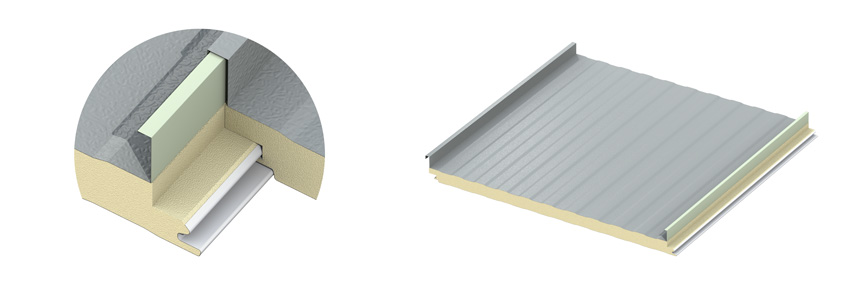
Available in a variety of modules, thicknesses, and lengths, insulated metal panels lend a nice aesthetic to the building roof.
When the roof panels are combined with IMP wall panels, this not only creates a nice uniform aesthetic, but a compatibility of materials is assured along the all-important roof-to-wall transition and overall building enclosure.
“IMPs have developed from the early ribbed metal-faced panels to now include a variety of smooth and textured metal modular wall panels integrated with reveals, trim, windows, and louvers,” reports Kazba.
In order to stiffen the panel faces, an embossed surface texture is typically applied with various profiles rollformed into them, according to MCA. Profiles commonly include light striations or planking, deep ribbing, or stiffening beads.
Another popular add-in is embossing, which is a process used to create surface texture on metal coils. In addition to masking minor blemishes, such as paint scratches and surface variations, the embossing flattens wavy coils and eliminates the “mirror” effect of smooth finishes. Nondirectional embossing results in a wavy pattern, while directional embossing produces linear lines along the length of the coil.
In terms of the specific material used for the panels, the most common metal substrate for panel faces is G90 galvanized steel, but stainless steel, aluminum-zinc-coated steel, and aluminum are used as well.
For instance, one leading IMP manufacturer adds in a zinc coating to its G90 sheet steel at a thickness of 0.9 ounces per square foot of metal on both sides for corrosion resistance. This creates an approximate thickness of 0.8 millimeter per side.
It’s also worth noting that the composite action between the flat skins and foam core create a structurally sound product. According to MCA, for a 2-inch panel, most wind load requirements in the 20 to 30 psf ranges can be met with 7-foot to 10-foot span conditions. Typically, panel capacity is controlled by the fastener system under negative wind loads.
Describing IMPs as sleek and subtle, when designed properly, Williamson advises selecting fasteners made of the same material to prevent metal corrosion, which could detract from the panels’ visual appeal.
Sharing some additional best practices when it comes to the design of IMP roofing systems, Kazba recommends working with modular dimension layouts coordinated with panel sizes in order to simplify cutting and joinery, and taking advantage of IMPs’ interior surface to eliminate the requirement for interior finishes. For the exterior, designers should specify high-quality finishes to ensure long panel finish life.
For instance, Kynar—made with a high percentage of polyvinylidene fluoride—is a common exterior paint finish, while polyester is a standard paint finish for the interior. For high-humidity interiors, some wash-down areas, and cases where thicker paint film is required, USDA-compliant polyvinyl chloride paint is a good choice. For both finishes, the interior coatings are easy to clean and offer high light reflectivity.
Because the coatings are factory applied and are well-suited for IMPs, the result is a longer life finish, as compared to other exterior system options.
Kazba also advises selecting electrical and datacom distribution techniques that do not require concealment in outside walls and limiting through-roof penetration of building services, for example, going with ground or enclosed space for mechanical equipment, as opposed to roof-mounting, where possible.
Similarly, MCA’s guide states that penetrations should be kept to a minimum. Where required, small penetrations should be sealed with boots or stack flashings. For larger roof penetrations, a factory-welded curb with additional structural support is the most ideal solution.
Overall, Koziol recommends providing shop drawings early in the project, which delineate the more unique details for the particular job outside of the canned, generic details for standard conditions.
He also emphasizes the importance of paying close attention to properly sealing the panel endlap and sidelap joints and seams. These elements should also be detailed and constructed in a way that maintains the same thermal value as the body of the panel, as this will help provide the desired continuous insulation requirements directed by the energy codes.
“Also, be sure to provide detailing that maintains thermal and moisture barrier redundancy at all of the interface details with edge terminations, intersecting walls, and penetrations, especially if the roof geometry is complex or has a low slope of 3:12 or less. Develop detailing that is not reliant on sealant joints alone for water tightness,” states Koziol.
Fortunately, Kazba points out, “Combining IMP roof and wall panels creates a highly sealed condition at the roof/wall joint, something that is more difficult to accomplish with conventional building assemblies.”
When it comes to properly joining the panels, Williamson directs designers to carefully follow the manufacturer’s manual, as this is key to ensuring the functionality of the IMPs. Similarly, the panels must be aligned correctly, as they rely on linear seal technology, and misaligned panels could lead to severe structural problems, which may be difficult and costly to rectify.
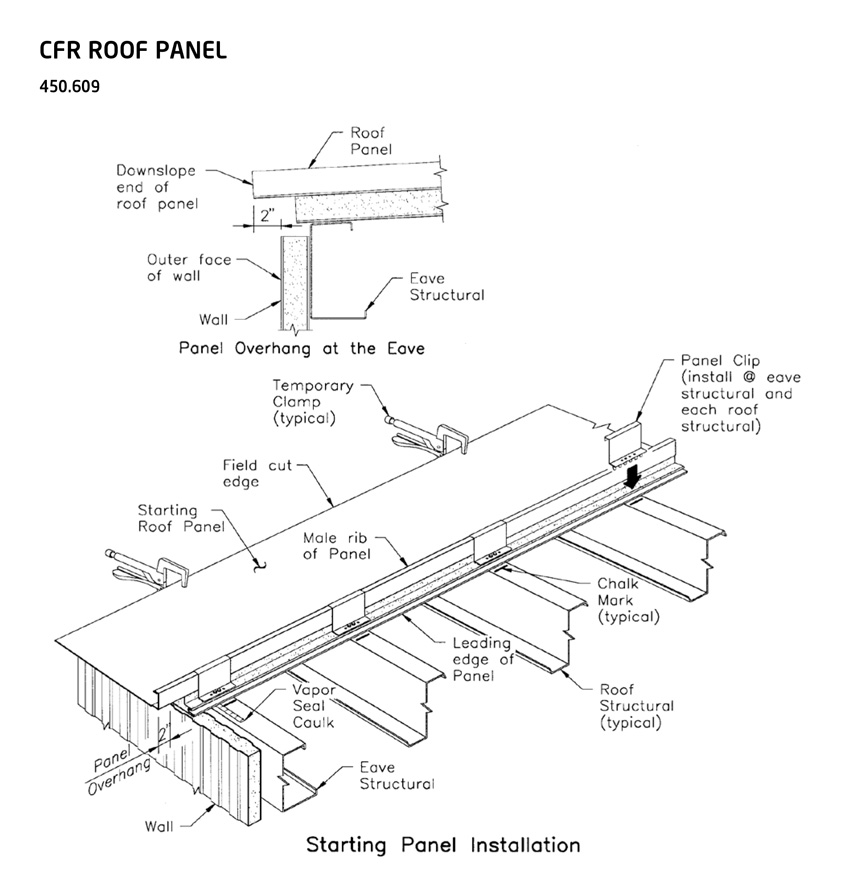
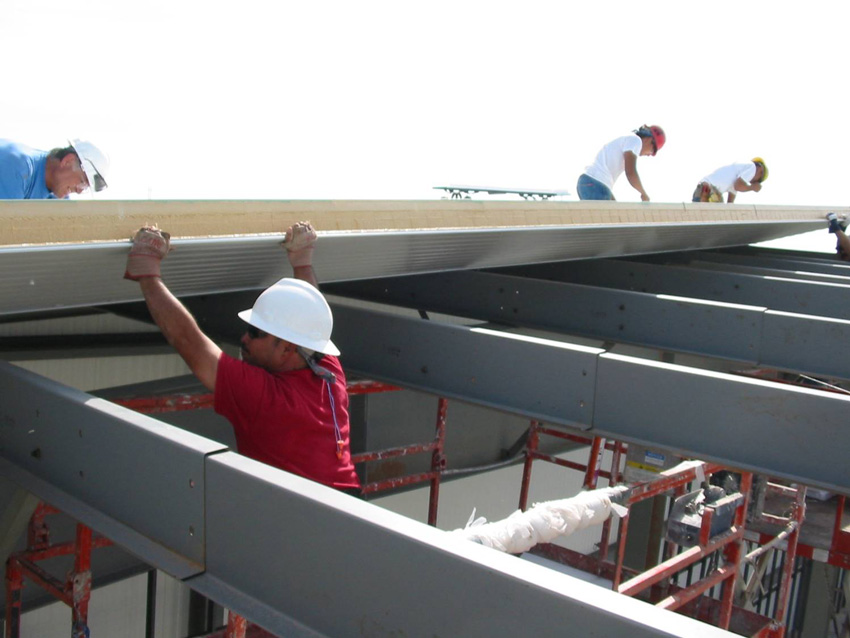
When installing the first panel, leave a 1-inch gap for field-applied insulation.
Offering some direction here, MCA’s guide states that the support alignment should not deviate more than 1/4 inch in any 20-foot length at any direction. In addition, the total alignment envelope should be plus or minus 1/2 inch over the entire panel surface, excluding transition areas, such as building corners and soffit areas where the alignment must be within 1/8 inch of the theoretical girt plane in order to accommodate formed transition or corner panels.
In the case where there is variation in the steel alignment from the theoretical plane, the panels should all be oriented in an outward direction. Alternatively, if one purlin is on the plus side and the adjacent purlin is on the minus side, this can cause stress on the insulated panels at an unacceptable level.
“For example,” says the guide, “an insulated roof panel spanning 5 feet with a deflection limit of L/180 will deflect a maximum of 1/3 inch. If the purlin supporting the panel is designed with the deflection limit of L/240 and spans 25 feet, the allowable deflection for the purlin is 11/4 inches, and this can lead to excessive deflection and stress on both the panels and panel connection.”
As another point of reference, one leading manufacturer’s insulated metal standing seam roof panel installation guide lists the following standard framing alignment tolerances:
- Out of square: 1/4 inch of saw tooth tolerance
- Structure length: An overall +/- 2-inch rake-to-rake tolerance or +/- 1 inch at each rake
- Structure width: An overall +/- 1-inch eave-to-rake tolerance or +/- 1/2 inch at each eave, endlap, and ridge
- Vertical alignment: Vertical deviation from the nominal roof plane of +/- 1/8 inch in any 5-foot length, +/- 1/4 inch in any 20-foot length, and +/- 1/2 inch over the entire roof area
In line with MCA’s cautionary note about tolerances, the manufacturer’s instructions also state that excessive vertical misalignment between adjacent framing members will cause deflection (i.e., bending of the installed panel). This can then create an improper side joint assembly when attempting to install the next panel. Furthermore, a combination of thermal stress and wind stress on the deflected panel may cause buckling of the panel face.
As much is at stake here, in terms of getting the specifications just right, Halle advises the design team not to hesitate getting the manufacturer and installer involved in the design process.
Along these lines, certain design preferences may need to be established with the manufacturer as early as possible, for example, specifying a certain color so that it can be fabricated in a timely manner. Or, in the case where a support system spans from the top of the slab to the underside of the roof assembly, the IMP manufacturer will need to be asked to detail the panels so there is no movement that could damage the panels and the surrounding area, explains Williamson.
Architects should also take advantage of the manufacturer’s expertise to provide training for the installing team.
Here, Koziol points out that the nature of IMP roof systems is such that a higher degree of attention to detail and better-than-average workmanship is required to deliver a high-quality end product. As a result, he recommends the installer be highly experienced and sheet metal roofers are retained to do the flashing details, as opposed to using steel or metal building erectors.
On the same page, BCRA Nexus specifies a minimum five years of successful and documented installation experience on any roofing project.
Prepare to Install
“Prior to installation, preinstallation meetings are essential for all trades,” says Wolf, “particularly those involved in the air barrier installation. This enables discussions on material transitions and how to handle hand-offs from one trade to another. Fortunately, IMPs provide a more complete assembly, reducing the number of trades involved, thereby simplifying coordination.”
Even so, it’s important to have an IMP technical representative review the structural framing specification tolerances shop drawings, and attend the structural framing preconstruction conference to ensure the erector understands the tolerances required for successful IMP installation, according to Kazba. “IMPs should not be field modified, so this means the substrate flatness and squareness tolerances must be met.”
“Perform a thorough examination of the erected structure and require modifications to out-of-tolerance work before commencing IMP installation,” he adds.
Another IMP preinstallation requirement is checking the “as-built” conditions and correcting any deficiencies. Building team meetings, including all the trades, should also take place on a regular basis to promote continued discussions about the interfaces between the roof and other assemblies.
Putting this into practice, Gilbane conducted multiple design and preinstall meetings with the designer, A/E and IMP manufacturer for a soon-to-be-completed project at the University of Iowa Children’s Hospital in Iowa City, where an IMP system for a canopy and vestibule roof is wrapped around the circumference of the building.
“Another key quality assurance measure is building a mockup of the installation and testing it for water leakage,” says Keleher, “in addition to bringing in a building enclosure consultant to advise on proper detailing for flashing systems.”
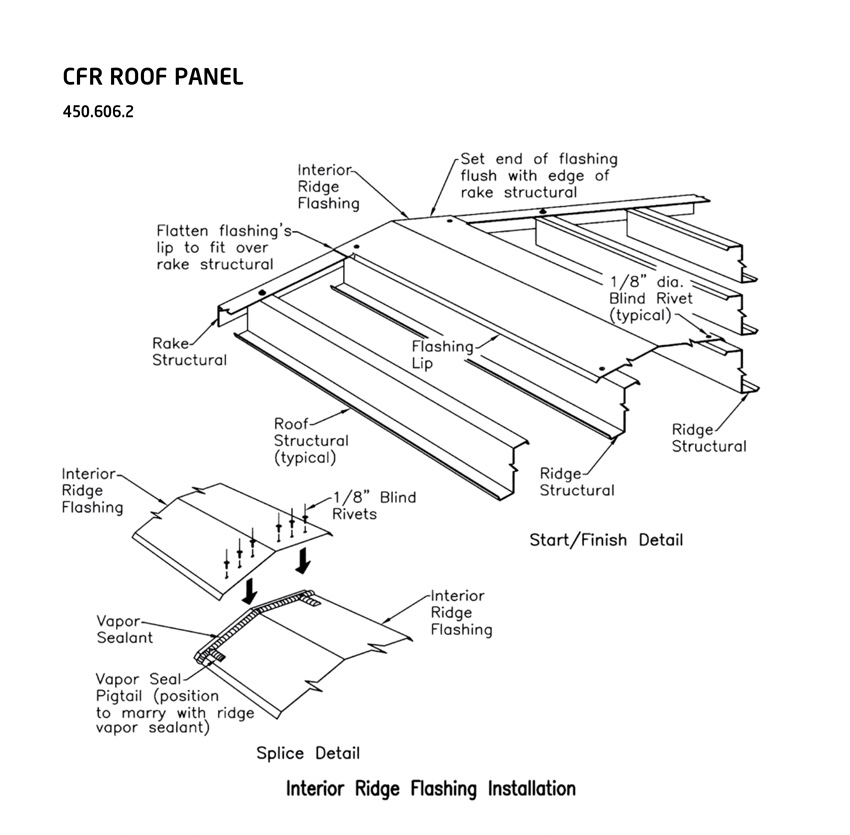
Flashing systems must be properly applied to the IMP roofing system to ensure weather-tight protection.
Adding in his own piece of advice, Halle suggests both utilizing the IMP manufacturer’s quality assurance and quality control list in addition to drawing up one’s own QAQC punch list.
For the actual IMP installation, while there are a number of steps to follow, bear in mind that the product is installed as a single element, as opposed to the multiple components and installation steps required by other insulated roof systems.
While issues such as correct panel alignment and accurately applying the clips to connect the panels are important, achieving proper air and water infiltration is also essential. Here, MCA’s guide states that a proper seal system is imperative. The most common strategy is a liner side seal network, which involves field applying non-skinning butyl sealant on the structural steel at the panel ends and connecting them to either shop- or field-applied sealant located in the panel side joint.
This will enable each panel to have a complete perimeter of butyl sealant on the liner or warm side, effectively creating a great vapor barrier. At transition areas, including corners or wall-to-soffit edges, proper liner trim is needed to maintain the liner seal continuity.
“For weather tightness, most insulated metal roof panels require a concealed bead of sealant on the exterior of the panel side joint,” says MCA’s guide. “Continuity of panel caulking is critical. All joints and overlaps must be completely caulked to prevent water and air infiltration. Caulking of endlap panel joints is especially key where the lap occurs in the ‘low’ flutes of the panels.”
For the IMP system to work properly, the panels must be precisely aligned. In particular, for the system’s liner seal technology to be effective, proper girt steel alignment must be employed to assure the system’s weather integrity.
Designers and contractors should also be aware that compared to concrete or masonry cladding, metal panel systems have higher coefficients of expansion for thermal movement. This means that expected movement amongst the panels must be calculated, and joints between panels should be wide enough to accommodate thermal expansion and differential movements between panels. Ranging from 1/4-inch wide for small panels to 1-inch wide for larger panels, precisely sizing the joint is based upon panel size, panel location on the building, and tolerance issues.
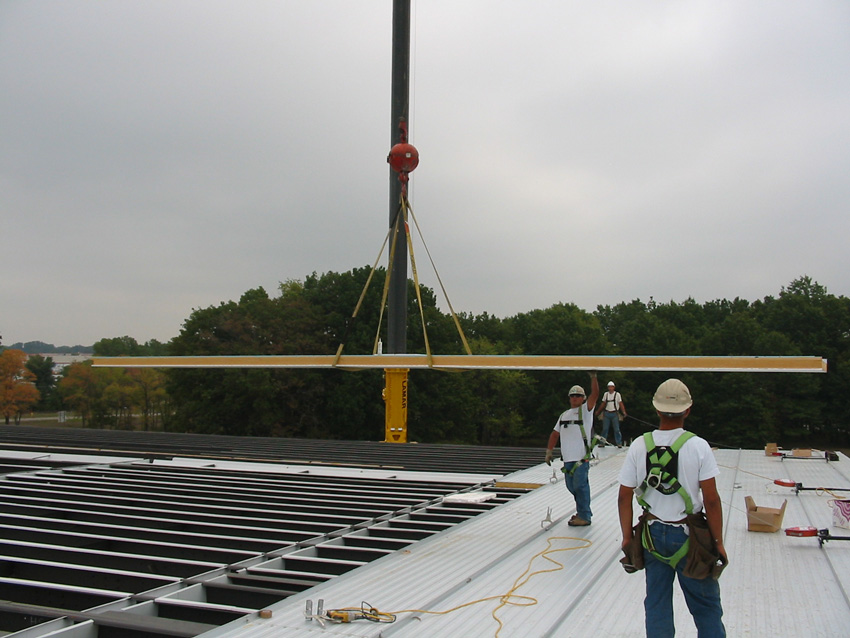
Prior to installing the IMP roofing panels, thermal expansion and differential movements between panels should be accounted for.
“It all comes down to measurements and compatibility,” confirms Williamson. “There will always be panel movement due to changes in heat and weather conditions so it is vital that you accommodate for this movement and ensure the panels can move slightly without becoming damaged.”
Because panel lengths are often restricted by shipping and handling limitations, it will sometimes be necessary to provide an endlap joint for IMP roof panels. Usually, the liner and foam core will be cut away, which leaves a nominal exterior face extension for a lap over the lower panel. Of course, the length of the extension and endlap depends on the roof slope and panel profile. The endlap joints should then be caulked and fastened according to the roof panel manufacturer’s recommendations.
“Installing liberal and thoroughly continuous sealant beads and spray foam insulation is really important to make each and every seal at an endlap or sidelap a perfect one, which it needs to be,” says Koziol.
Worth the While
Whether it’s IMPs all-in-one building enclosure solution, its fast-tracked erection requiring only one trade for installation, or its multipurpose benefits as a structural deck, insulation, and finish systems, the technology deserves a serious consideration for a number of building types.
“When combined with the inherent benefits of metal facings, insulated metal panels require less maintenance than other exterior systems and meet the most demanding performance requirements,” concludes MCA’s guide.

|
Metl-Span is a dynamic industry innovator dedicated to manufacturing and marketing the highest-quality insulated building panel products. Since our origination in 1968, we have been pioneers in research, design, production, and sales of state-of-the-art insulated metal panels and building materials serving the commercial, industrial, and cold storage industries. We are a recognized leader in the advancement of insulated metal panel technology. With our history of visionary product design—and by consistently setting the highest standards in technological advances—architects, designers, and builders trust Metl-Span panel products to perform reliably, be aesthetically pleasing, and come with a proven sustainability track record. Structural integrity, tireless testing, and a determination to exceed expectations are primary to Metl-Span’s focus. At Metl-Span, form meets function in the most reliable, cost- and energy-efficient manner possible. www.metlspan.com |

